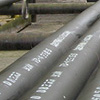

Hunan Standard Steel Co.,Ltd es uno de los miembros de Husteel Industry Group, como fabricante profesional de tuberías y accesorios de tubería de acero dulce, que tiene un sistema completo de producción ... Más
Fábrica GrupoThe Basic Principle of Eddy Current Testing
fecha:2016-08-01
Vista:2474
Eddy current testing is one of many NDT method, it is applied - the basic theory of electromagnetism as a basis conductor detection. Vortex generated from the phenomenon called electromagnetic induction. When alternating current is applied to the conductor, for example copper wire, a magnetic field is generated in the magnetic field surrounding the conductor and the conductor space. Eddy current is induced, which flows in a loop. It is called - vortex ‖, because it is surrounded with a liquid or a gas barrier in the loop flowing form is the same. If a conductor is placed in the varying magnetic field, eddy currents generated in the conductor, and the eddy currents also produce their own magnetic field with alternating current rises and expansion, with the alternating current decreases and blanking. So when some of the properties of the conductor surface or near-surface defects or measuring metal material changes will affect the intensity and distribution of the vortex, so we can change the situation together to detect the vortex, and thus may be internally indirect knowledge questions performance deficiencies exist and whether the metal has changed.
Eddy current NDT as a tool of big advantage is that it can do a variety of inspection and measurement. In the right environment, eddy current can be used:
1, Crack, defect inspection
2, The material thickness measurement
3, Coating thickness measurement
4, The conductive material is measured
Advantages of eddy current testing include:
1, Sensitivity to small cracks and other defects
2, Detection of surface and near surface defects speed, high sensitivity
3, The test results are immediacy
4, Good device interface
5, Only need to make a few preparations
6, The test probe does not require contact with the measured object
7, You can check the shape and size of complex conductor
Eddy current NDT as a tool of big advantage is that it can do a variety of inspection and measurement. In the right environment, eddy current can be used:
1, Crack, defect inspection
2, The material thickness measurement
3, Coating thickness measurement
4, The conductive material is measured
Advantages of eddy current testing include:
1, Sensitivity to small cracks and other defects
2, Detection of surface and near surface defects speed, high sensitivity
3, The test results are immediacy
4, Good device interface
5, Only need to make a few preparations
6, The test probe does not require contact with the measured object
7, You can check the shape and size of complex conductor
























